What Are the Solutions to Climate Change?
Some solutions are big and will require billions in investment. Some are small and free. All are achievable.

Bundei Hidreka (left), a member of the Orissa Tribal Women's Barefoot Solar Engineers Association, holds up a solar lantern in Tinginaput, India.
Abbie Trayler-Smith/DFID, CC BY-NC-ND 4.0
Thinking about climate change can be overwhelming. We’ve been aware of its causes for decades now, and all around us, we bear witness to its devastating effects on our communities and ecosystems.
But the good news is that we now know exactly what it will take to win the fight against climate change, and we’re making measurable, meaningful progress. Game-changing developments in clean energy, electric vehicle technology, and energy efficiency are emerging every single day. And countries—including Canada, China, India, and the United States—are coordinating and cooperating at levels never seen before in order to tackle the most pressing issue of our time.
The bottom line: If the causes and effects of our climate crisis are clearer than ever, so are the solutions.
Ending our reliance on fossil fuels
The single-most important thing that we can do to combat climate change is to drastically reduce our consumption of fossil fuels. The burning of coal, oil, and natural gas in our buildings, industrial processes, and transportation is responsible for the vast majority of emissions that are warming the planet—more than 75 percent, according to the United Nations. In addition to altering the climate, dirty energy also comes with unacceptable ecological and human health impacts.
We must replace coal, oil, and gas with renewable and efficient energy sources. Thankfully, with each passing year, clean energy is making gains as technology improves and production costs go down. But according to the Intergovernmental Panel on Climate Change's Special Report on Global Warming of 1.5°C, in order to meet the goal of reducing global carbon emissions by at least 45 percent below 2010 levels before 2030—which scientists tell us we must do if we’re to avoid the worst, deadliest impacts of climate change—we must act faster.
There are promising signs. Wind and solar continue to account for ever-larger shares of electricity generation. In 2021, wind and solar generated a record 10 percent of electricity worldwide. And modeling by NRDC has found that wind, solar, hydro, and nuclear could account for as much as 80 percent of U.S. electricity by the end of this decade. (We can also fully realize our clean energy potential if we invest in repairing our aging grid infrastructure and installing new transmission lines.) While this transformation is taking place, automakers—as well as governments—are preparing for a future when the majority of vehicles on the road will produce zero emissions.
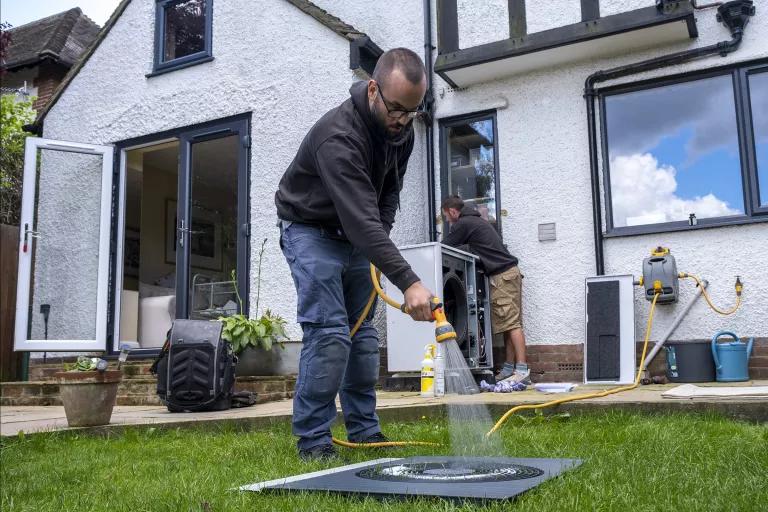
Technicians from Solaris Energy carry out the first-annual servicing and cleaning on a heat pump that was installed into a house originally built in the 1930s, in Folkestone, United Kingdom.
Andrew Aitchison / In pictures via Getty Images
Greater energy efficiency
Energy efficiency has been referred to as “the first fuel”; after all, the more energy efficient our systems are, the less actual fuel we have to consume, whether rooftop solar energy or gas power. Considered this way, efficiency is our largest energy resource. As the technology harnessing it has advanced over the past 40 years, efficiency has contributed more to the United States’s energy needs than oil, coal, gas, or nuclear power.
What’s more, energy efficiency strategies can be applied across multiple sectors: in our power plants, electrical grids, factories, vehicles, buildings, home appliances, and more. Some of these climate-friendly strategies can be enormously complex, such as helping utility companies adopt performance-based regulation systems, in which they no longer make more money simply by selling more energy but rather by improving the services they provide. Other strategies are extraordinarily simple. For example, weatherproofing buildings, installing cool roofs, replacing boilers and air conditioners with super-efficient heat pumps, and yes, switching out light bulbs from incandescent to LED can all make a big dent in our energy consumption.
Renewable energy
Transitioning from fossil fuels to clean energy is the key to winning the fight against climate change. Here are the most common sources of renewable energy—and one source of decidedly nonrenewable energy that often gets included (falsely) in the list.
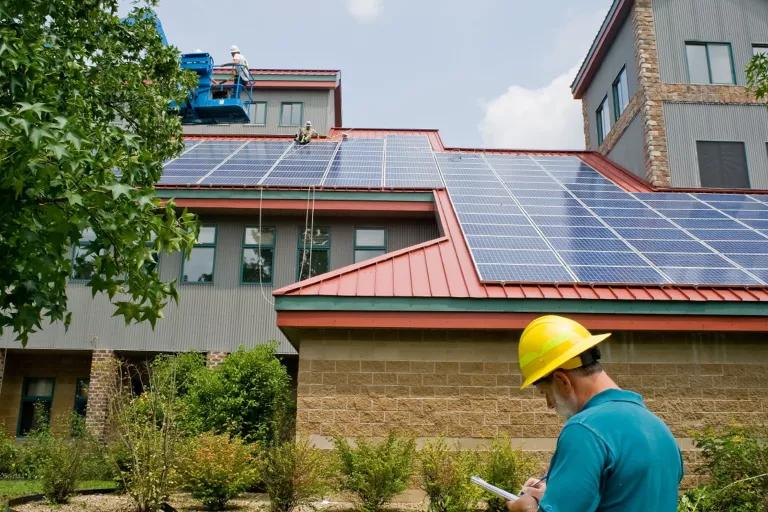
Engineer Steve Marchi and his team perform a final review of rooftop solar panels as part of the solar expansion project at the Wayne National Forest Welcome Center, in Ohio.
Alex Snyder/Wayne National Forest
Solar energy
Solar energy is produced when light from the sun is absorbed by photovoltaic cells and turned directly into electricity. The solar panels that you may have seen on rooftops or at ground level are made up of many of these cells working together. By 2030, at least one in seven U.S. homes is projected to have rooftop solar panels, which emit no greenhouse gases or other pollutants, and which generate electricity year-round (in hot or cold weather) so long as the sun is shining. Solar energy currently accounts for just under 3 percent of the electricity generated in the United States—enough to power 18 million homes—but is growing at a faster rate than any other source. By 2035, it could account for as much as 40 percent of electricity generation. From 2020 through 2026, solar will account for more than half of new electricity generation worldwide.
What to do when the sun doesn’t shine, you might ask. Alongside the boom in solar has been a surge in companion battery storage: More than 93 percent of U.S. battery capacity added in 2021 was paired with solar power plants. Battery storage is key to the clean energy revolution—and adapting to a warming world. Not only are batteries important at night when the sun isn’t out, but on hot days when homes draw a lot of electricity to power air conditioners, battery storage can help manage the energy demand and control the threat of power failures.
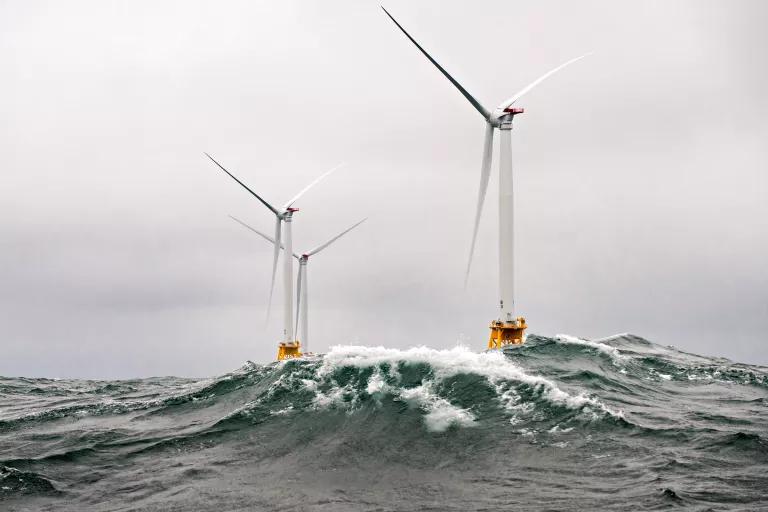
Turbines on Block Island Wind Farm, located 3.8 miles from Block Island, Rhode Island, in the Atlantic Ocean
Dennis Schroeder/NREL, 40481
Wind energy
Unlike solar panels, which convert the sun’s energy directly into electricity, wind turbines produce electricity more conventionally: wind turns the blades of a turbine, which spin a generator. Currently, wind accounts for just above 9 percent of U.S. electricity generation, but it, like solar, is growing fast as more states and utilities come to recognize its ability to produce 100 percent clean energy at a remarkably low cost. Unsurprisingly, states with plenty of wide-open space—including Kansas, Oklahoma, and Texas—have huge capacity when it comes to wind power, but many analysts believe that some of the greatest potential for wind energy exists just off our coasts. Offshore wind even tends to ramp up in the evenings when home electricity use jumps, and it can produce energy during the rainy and cloudy times when solar energy is less available. Smart planning and protective measures, meanwhile, can ensure we harness the massive promise of offshore wind while limiting or eliminating potential impacts on wildlife.
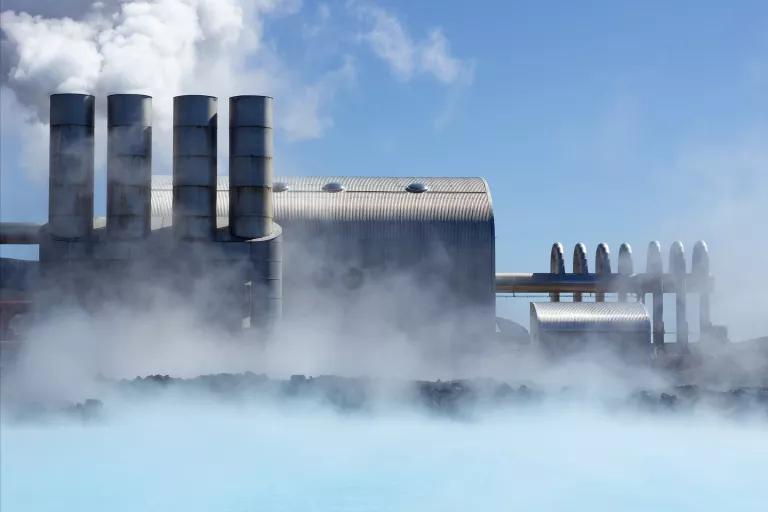
Svartsengi geothermal power plant in Iceland
Daniel Snaer Ragnarsson/iStock
Geothermal and hydroelectric energy
Along with sunlight and wind, water—under certain conditions—can also be a source of renewable energy. For instance, geothermal energy works by drilling deep underground and pumping extremely hot water up to the earth’s surface, where it is then converted to steam that, once pressurized, spins a generator to create electricity. Hydroelectric energy uses gravity to “pull” water downward through a pipe at high speeds and pressures; the force of this moving water is used to spin a generator’s rotor.
Humans have been harnessing heat energy from below the earth’s surface for eons—just think of the hot springs that provided warmth for the people of ancient Rome. Today’s geothermal plants are considered clean and renewable so long as the water and steam they bring up to the surface is redeposited underground after use. Proper siting of geothermal projects is also important, as recent science has linked some innovative approaches to geothermal to an increased risk of earthquakes.
Hydroelectric plants, when small-scale and carefully managed, represent a safe and renewable source of energy. Larger plants known as mega-dams, however, are highly problematic. Their massive footprint can disrupt the rivers on which people and wildlife depend.
Biomass energy
With very few exceptions, generating electricity through the burning of organic material like wood (sourced largely from pine and hardwood forests in the United States), agricultural products, or animal waste—collectively referred to as biomass—does little to reduce carbon emissions, and in fact, does far more environmental harm than good. Unfortunately, despite numerous studies that have revealed the true toll of this form of bioenergy, some countries continue to buy the biomass industry’s false narrative and subsidize these projects. Attitudes are changing but, given the recent wood pellet boom, there is a lot more work to be done.

A new electric bus on King Street in Honolulu, on June 16, 2021
Marco Garcia for NRDC
Sustainable transportation
Transportation is a top source of greenhouse gases (GHG), so eliminating pollution from the billions of vehicles driving across the planet is essential to achieving net-zero global emissions by 2050, a goal laid out in the 2015 Paris climate agreement.
In 2021, electric vehicles (EVs) accounted for less than 8 percent of vehicle sales globally; by 2035, however, it’s estimated that they’ll account for more than half of all new sales. Governments around the world aren’t just anticipating an all-electric future; they’re bringing it into fruition by setting goals and binding requirements to phase out the sale of gas-powered internal combustion engine (ICE) vehicles. That year, 2035, is expected to mark a turning point in the adoption of EVs and in the fight against climate change as countries around the world—as well as numerous automakers—have announced goals to phase out gas-powered cars and light trucks. This shift will also benefit our grid: EVs are like a “battery on wheels” and have the potential to supply electricity back to the network when demand peaks, helping to prevent blackouts.
It’s also critical that we consider all of the different ways we get around and build sustainability into each of them. By increasing access to public transportation—such as buses, ride-sharing services, subways, and streetcars—as well as embracing congestion pricing, we can cut down on car trips and keep millions of tons of carbon dioxide out of the atmosphere every year. And by encouraging zero-emission forms of transportation, such as walking and biking, we can reduce emissions even more. Boosting these alternate forms of transportation will require more than just talk. They require funding, planning, and the building out of supportive infrastructure by leaders across the local, state, and national levels.
To address the full set of impacts of the transportation sector, we need holistic and community-led solutions around things like land-use policies and the way we move consumer goods. Communities closest to ports, truck corridors, rail yards, and warehouses are exposed to toxic diesel emissions and face a high risk of developing acute and chronic public health diseases. Like all climate solutions, long-lasting change in the transportation sector requires building the power of historically marginalized communities.

An Association for Energy Affordability (AEA) worker installs a new energy-efficient window at an apartment in the South Bronx, New York City.
Natalie Keyssar for NRDC
Sustainable buildings
The energy used in our buildings—to keep the lights on and appliances running; to warm them and cool them; to cook and to heat water—makes them the single-largest source of carbon pollution in most cities across the United States. Making buildings more energy efficient, by upgrading windows and adding insulation to attics and walls, for example, will bring these numbers down. That’s why it’s all the more important that we raise public awareness of cost- and carbon-saving changes that individuals can make in their homes and workplaces, and make it easier for people to purchase and install energy-efficient technology, such as heat pumps (which can both heat and cool spaces) and certified appliances through programs like Energy Star in the United States or EnerGuide in Canada.
Beyond the measures that can be taken by individuals, we need to see a dedication from private businesses and governments to further building decarbonization, which simply means making buildings more efficient and replacing fossil fuel–burning systems and appliances with clean-powered ones. Policy tools can help get us there, including city and state mandates that all newly constructed homes, offices, and other buildings be outfitted with efficient all-electric systems for heating, cooling, and hot water; requirements that municipalities and states meet the latest and most stringent energy conservation standards when adopting or updating their building codes would also be impactful. Indeed, many places around the world are implementing building performance standards, which require existing buildings to reduce their energy use or carbon emissions over time. Most important, if these changes are going to reach the scale needed, we must invest in the affordable housing sector so that efficient and decarbonized homes are accessible to homeowners and renters of all incomes.
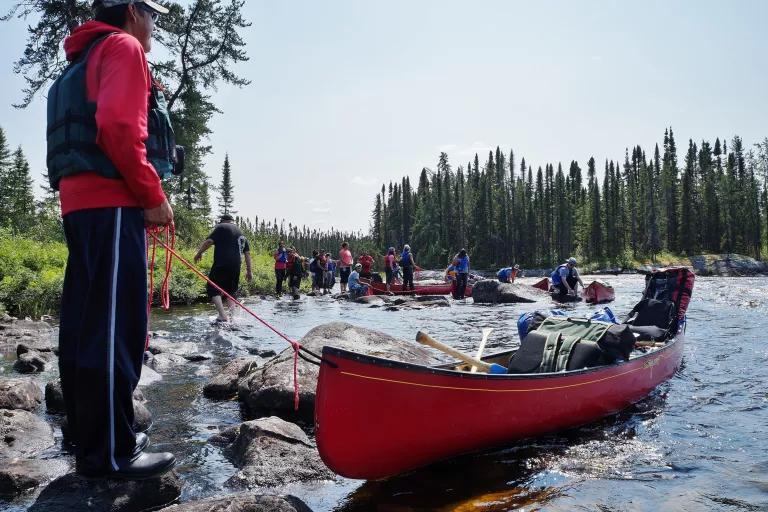
Nicolas Mainville joins a canoe trip with youth from the Cree First Nation of Waswanipi on a river in Waswanipi Quebec, Canada, which is part of the boreal forest.
Nicolas Mainville/Greenpeace
Better forestry management and sustainable agriculture
Some of our strongest allies in the fight against climate change are the trees, plants, and soil that store massive amounts of carbon at ground level or underground. Without the aid of these carbon sinks, life on earth would be impossible, as atmospheric temperatures would rise to levels more like those found on Venus.
But whenever we clearcut forests for timber or rip out wetlands for development, we release that climate-warming carbon into the air. Similarly, the widespread overuse of nitrogen-based fertilizers (a fossil fuel product) on cropland and generations of industrial-scale livestock farming practices have led to the release of unprecedented amounts of nitrous oxide and methane, powerful greenhouse gases, into our atmosphere.
We can’t plant new trees fast enough to replace the ones we clearcut in carbon-storing forests like the Canadian boreal or the Amazon rainforest—nor can rows of spindly young pines serve the same function as old-growth trees. We need a combination of responsible forestry policies, international pressure, and changes in consumer behavior to put an end to deforestation practices that not only accelerate climate change but also destroy wildlife habitat and threaten the health and culture of Indigenous communities that live sustainably in these verdant spaces. At the same time, we need to treat our managed landscapes with as much care as we treat wild ones. For instance, adopting practices associated with organic and regenerative agriculture—cover crops, pesticide use reduction, rotational grazing, and compost instead of synthetic fertilizers—will help nurture the soil, yield healthier foods, and pay a climate dividend too.

A school of fish swimming through a mangrove forest in the Caribbean Sea, off Belize
iStock
Conservation-based solutions
Intact ecosystems suck up and store vast amounts of carbon: Coastal ecosystems like wetlands and mangroves accumulate and store carbon in their roots; our forests soak up about a third of annual fossil fuel emissions; and freshwater wetlands hold between 20 and 30 percent of all the carbon found in the world’s soil. It’s clear we’re not going to be able to address climate change if we don’t preserve nature.
This is one reason why, along with preserving biodiversity, climate experts are calling on global leaders to fully protect and restore at least 30 percent of land, inland waters, and oceans by 2030, a strategy endorsed by the Intergovernmental Panel on Climate Change. To help us reach that goal, we must limit industrial impacts on our public lands and waters, continue to protect natural landscapes, support the creation of marine protected areas, uphold bedrock environmental laws, and follow the lead of Indigenous Peoples, many of whom have been faithfully and sustainably stewarding lands and waters for millennia.
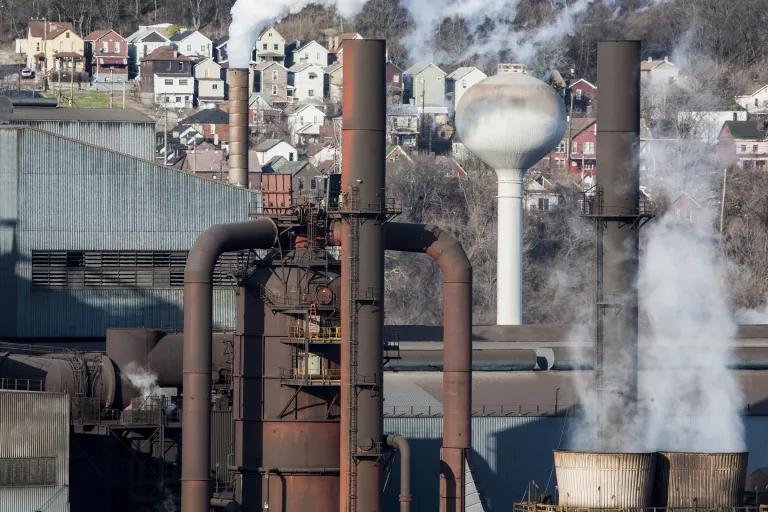
Emissions rise from the Edgar Thomson Steel Works, a steel mill in the Braddock and North Braddock communities near Pittsburgh, Pennsylvania.
Getty Images
Industrial solutions
Heavy industry—the factories and facilities that produce our goods—is responsible for a quarter of GHG emissions in the United States and 40 percent globally, according to the EPA. Most industrial emissions come from making a small set of carbon-intensive products: basic chemicals, iron and steel, cement, aluminum, glass, and paper. (Industrial plants are also often major sources of air and water pollutants that directly affect human health.)
Complicating matters is the fact that many industrial plants will stay in operation for decades, so emissions goals for 2050 are really just one investment cycle away. Given these long horizons for building and retrofitting industrial sites, starting investments and plans now is critical. What would successfully decarbonized industrial processes look like? They should sharply reduce heavy industry’s climate emissions, as well as local pollution. They should be scalable and widely available in the next decade, especially so that less developed nations can adopt these cleaner processes and grow without increasing emissions. And they should bolster manufacturing in a way that creates good jobs.
Technological solutions
Technology alone won’t save us from climate change (especially not some of these risky geoengineering proposals). But at the same time, we won’t be able to solve the climate crisis without researching and developing things like longer-lasting EV batteries, nonpolluting hydrogen-based solutions, and reliable, safe, and equitable methods for capturing and sequestering carbon. Because, while these tools hold promise, we have to make sure we don’t repeat the mistakes of the past. For instance, we can take actions to reduce local harms from mining lithium (a critical component of electric vehicle batteries), improve recycling opportunities for solar cells, and not use carbon capture as an excuse to pollute. To accelerate research and development, funding is the critical third leg of the stool: Governments must make investing in clean energy technologies a priority and spur innovation through grants, subsidies, tax incentives, and other rewards.
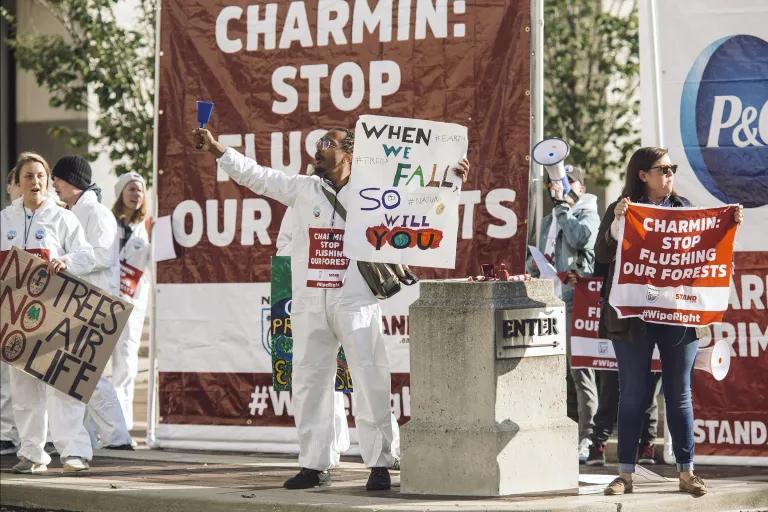
A protester rings a bell in front of P&G’s headquarters in Cincinnati; the company’s toilet paper brand, Charmin, uses wood pulp from virgin trees in Canada's boreal forest.
NRDC
Our choices
Finally, it should go without saying that we, as individuals, are key to solving the climate crisis—not just by continuing to lobby our legislators and speak up in our communities but also by taking climate actions in our daily lives. By switching off fossil fuels in our homes and being more mindful of the climate footprint of the food we eat, our shopping habits, how we get around, our use of plastics and fossil fuels, and what businesses we choose to support (or not to support), we can move the needle.
But it’s when we act collectively that real change happens—and we can do even more than cut down on carbon pollution. Communities banding together have fought back fracking, pipelines, and oil drilling in people’s backyards. These local wins aren’t just good news for our global climate but they also protect the right to clean air and clean water for everyone. After all, climate change may be a global crisis but climate action starts in your own hometown.
We have a responsibility to consider the implications of our choices—and to make sure that these choices are actually helping to reduce the burdens of climate change, not merely shifting them somewhere else. It’s important to remember that the impacts of climate change—which intersect with and intensify so many other environmental, economic, and social issues—fall disproportionately on certain communities, namely low-income communities and communities of color. That’s why our leaders have a responsibility to prioritize the needs of these communities when crafting climate policies. If those on the frontlines aren’t a part of conversations around climate solutions, or do not feel the benefits of things like cleaner air and better job opportunities, then we are not addressing the roots of the climate crisis.
This NRDC.org story is available for online republication by news media outlets or nonprofits under these conditions: The writer(s) must be credited with a byline; you must note prominently that the story was originally published by NRDC.org and link to the original; the story cannot be edited (beyond simple things such as grammar); you can’t resell the story in any form or grant republishing rights to other outlets; you can’t republish our material wholesale or automatically—you need to select stories individually; you can’t republish the photos or graphics on our site without specific permission; you should drop us a note to let us know when you’ve used one of our stories.
We need climate action to be a top priority in Washington!
Tell President Biden and Congress to slash climate pollution and reduce our dependence on fossil fuels.



How to Find Relief During Summer Heat Waves in the City
What Are the Causes of Climate Change?
How to Ditch the Biggest Fossil Fuel Offenders in Your Life